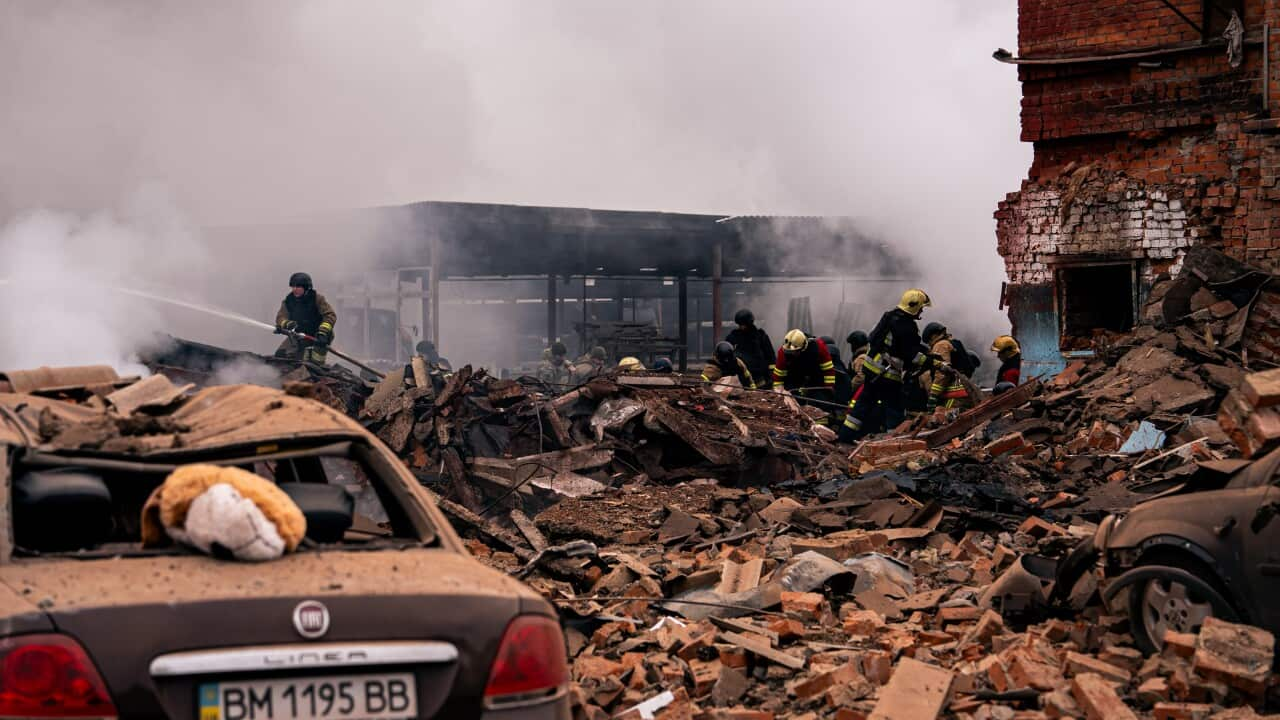Russia launched its second major attack on Ukraine’s energy infrastructure this month, causing widespread power outages across the country on Thursday.
President Vladimir Putin said Russian forces had struck in response to Ukraine’s strikes on Russian territory with medium-range ATACMS missiles supplied by the United States.
Fragments from downed Russian drones struck buildings in two Kyiv districts and injured one person after Putin threatened that Russia’s future missile targets could include “decision-making centres” in the Ukrainian capital.
Emergency services, in a post on the Telegram messaging app, showed pictures of rubble strewn about inside and outside a pediatric clinic in the city’s Dniprovskyi district on the east bank of the Dnipro River.
Mayor Vitali Klitschko said drone fragments had struck an infrastructure site in the Sviatoshynskyi district on the west bank of the river.
A children’s polyclinic in a residential area of Kyiv was struck by Russian drones on 28 November, according to Ukrainian authorities. Source: AAP / State Emergency Service of Ukraine/EPA
Ukrainian President Volodymyr Zelenskyy accused Russia of a “despicable escalation”, saying it had used cruise missiles with cluster munitions.
Later in his nightly video address, Zelenskyy said he was speaking to Western leaders, including NATO secretary general Mark Rutte, British Prime Minister Keir Starmer and German Chancellor Olaf Scholz, to forge a response to “Russia’s attempt to make the situation more unbearable and drag out the war”.
“Now is the time to strengthen our positions — the position of Ukraine and our partners,” he said.
Over one million people lost power in the immediate aftermath of the strikes, and millions more had their existing schedule of rolling power cuts intensified.
Ukraine’s air force said Russia used 91 missiles and 97 drones in Thursday’s attack. It said 12 of those had hit their targets, most of which were energy and fuel facilities.
“The enemy is using a large number of missiles and drones. Their massive use in certain areas often exceeds the number of means of (air defence) cover,” the Ukrainian air force said in a statement.
Infrastructure facilities were damaged in nine regions, Ukraine’s interior ministry said.
US President Joe Biden condemned the Russian attack as “outrageous”, saying in a statement that it serves as “another reminder of the urgency and importance of supporting the Ukrainian people in their defence against Russian aggression”.
The re-election of Donald Trump
Zelenskyy also claimed Putin’s escalated attack on Ukraine was directly related to the re-election of Donald Trump to the US presidency.
“Putin’s escalation now is a form of pressure aimed at eventually forcing the President of the United States to accept Russia’s terms,” he said.
Trump has criticised the billions the Biden administration has poured into Ukraine and said he could end the war in 24 hours.
about how much he would be willing to concede in negotiations over Ukraine’s future.
Putin insists he has set no preconditions to start talks with Ukraine on a possible peace settlement, but that terms he set out in June for a deal remained unchanged.
He said in June that Russia would end the war in Ukraine only if Ukraine agreed to drop its NATO ambitions and hand over the entirety of four provinces claimed by Moscow.
Ukraine has rejected those conditions as tantamount to surrender.
Power cuts during winter loom
The recent barrage of attacks on Ukraine reinforced fears of long power cuts during the winter months as temperatures hover around zero.
Officials said it was the 11th major strike on the energy system since March. Russia has knocked out about half of Ukraine’s available generating capacity during the war, damaged the distribution system and forced authorities to impose long blackouts.
The air force said it had shot down 79 missiles and downed 35 drones, while 62 drones were “lost”, meaning it was likely they had been disrupted by electronic warfare.
All missiles or drones aimed at the capital, Kyiv, were brought down, officials said.
A source in the energy sector said Ukraine had disconnected all nuclear power units from the grid before the attack to protect them. Ukraine gets more than half of its electricity from nuclear plants.
Ukraine’s state grid operator Ukrenergo, announced deep power cuts across the country because of damage from the attacks, warning of at least 12 hours without electricity for some consumers.
Associated Press reporter Hanna Arhirova — who’s based in central Ukraine — says the country has been finding it more difficult to cope with regular Russian attacks on its energy infrastructure.
“It started attacking Ukraine’s energy system two years ago in autumn, and since then Ukraine’s energy system was devastated, and it has lost a significant part of its infrastructure.
“That’s the reason why rolling blackouts have become a common thing. But every such big attack actually makes it more difficult for the energy system, and people have to cope with longer hours spent in darkness.”
Russian forces advancing at a rapid pace
More than 33 months after Russia invaded Ukraine, Russian ground forces are advancing at their fastest pace in two years.
Russia fired a new hypersonic intermediate-range ballistic missile at Ukraine this month after the United States allowed Ukraine to strike Russian territory with advanced Western missiles.
“Putin does not want peace. We must force him into peace through strength,” foreign minister Andrii Sybiha said, reiterating Ukraine’s call for more air defence and long-range capabilities from Western allies.
In western Ukraine, Lviv regional governor Maksym Kozytskyi said Thursday’s Russian strikes had cut off electricity to about 523,000 people. Power was also cut to nearly 500,000 people in the Volyn and Rivne regions, their governors said, and disrupted in the Khmelnytskyi and Zhytomyr regions.
State oil and gas firm Naftogaz said its facilities had been attacked in the morning airstrikes.
Officials across Ukraine said they were turning on generators to ensure emergency heat and water supplies to hospitals, schools and other critical facilities during bitter winter weather.


